by Winding Pathways | Jan 8, 2016 | Nature, Pests
Most people love watching wildlife in their yards, and millions set out bird feeders and improve habitat to encourage colorful and fascinating animals. But there’s a limit.
See a mouse scurry across the floor or find their droppings on the kitchen counter and most families quickly set snap traps to kill the pests. Although there are ways to reduce or prevent most wildlife problems that usually should be tried first, sometimes it’s necessary to kill an animal.
Take woodchucks, for example. These large mammals are capable climbers and powerful diggers. They tunnel under any fence they can’t climb over. A woodchuck’s sweet tooth is the family garden and they readily clear cut carrots, peas, beans, corn, chard and most other crops.
A few July’s ago our garden looked superb. We were harvesting crops like beans, squash, beets and chard. One afternoon we went out to pick a few dinner vegetables and were astonished to find the beans nearly eaten to the ground, the chard gone and the beet tops nibbled to nubbins. It wasn’t the raid of a woodchuck. A whole family of chucks had chosen to squeeze under the fence and convert our garden into their lunch.
We do what we can to prevent or reduce damage. The garden has a sturdy fence around it that keeps deer and rabbits out, but with their superior climbing and digging ability we found that keeping chucks out is nearly impossible.
Our garden is a vital part of our family’s food supply so raiding woodchucks gets the same treatment as a mouse in the kitchen. Fortunately, our home is situated where it is legal and safe to shoot an occasional garden raider. Millions of homeowners live on acreages where they can legally dispatch pests. But it must be done safely. Having a low power firearm or airgun handy can be a garden savior.
We use both a .22 caliber rifle and a .22 caliber airgun both to dispatch an occasional pest and for target practice. Again, shooting a pest is a last resort that we use only when prevention fails, but normally we have to do in a few woodchucks every year.
HOW FIREARMS AND AIRGUNS WORK
Airguns and firearms have similarities and differences. Each relies on air pressure to push a projectile (bullet or pellet) out the barrel and onward to its target. Each can be a safe, effective, and humane tool for dispatching pests but must be used with great care and moderate skill.
When someone pulls a firearm’s trigger a pin strikes the primer of a loaded shell. The impact causes the primer to create a spark that ignites gunpowder. Rapidly burning powder creates tremendous air pressure that pushes the bullet out the barrel.
Pull the trigger on an airgun and high pressure air, already inside, pushes the projectile forward without an explosion of gunpowder. The pressure is generated before shooting by either pumping the barrel or a lever or by inserting a cartridge of pressurized carbon dioxide.
DEVELOPING SHOOTING SKILL
Appropriate airguns and .22 rifles are capable of quickly and humanely dispatching small pests but each can cause severe injury or even death of a person. They must be used with skill and care. Winding Pathways owners Rich and Marion Patterson have extensive experience with firearms. She grew up in rural New Hampshire in a family that hunted for food and also occasionally needed to dispatch a pest raiding their huge garden. He learned shooting during a stint in the army. Many homeowners lack shooting skills and safety knowledge. A good way to gain both is to enroll in a hunter safety course offered in most areas. To locate a class check Where to Hunt. Instructors help novices learn safety and accurate shooting. Many shooting ranges also offer training and are excellent and safe places to practice, sometimes with a coach to help out. To locate a range near your home access Where To Shoot.
Accurate shooting is essential for humane and safe pest control. A precise shot to the vitals will instantly kill a woodchuck while a poor shot will only wound the animal and cause suffering. Develop skill and practice!
.22 RIFLES
At Winding Pathways we often spot our garden-raiding woodchuck close to our home and use our .22 rimfire rifle to dispatch it. Ours is a bolt action that functions with a diversity of ammunition types. The most powerful are called “long rifle” shells. We avoid them because they are overly powerful and noisy. Instead we use either “shorts” or, more frequently, “CB” shells. CB shells have only a small amount of powder and make little noise. They have plenty of power to dispatch a woodchuck hit in the head at 25 feet. Shorts have more power than CB’s but less than long rifles. They extend the effective range but are noisier.
AIRGUNS
Airguns, sometimes called BB guns, vary greatly in quality and power. Old fashioned BB guns fired a round piece of steel called a “BB”. Generally they lack both power and accuracy for serious pest control, but modern airguns are a different matter. Many are of .177 caliber but some are of .22 caliber, which fire a larger heavier pellet that is more lethal than the smaller one. A common system of charging an airgun is to compress air by cocking the barrel. Some airguns will dispatch a pest as humanely as a firearm, but be careful.
Please note: There are pellet guns and there are pellet guns. Some are powerful enough to humanely dispatch a woodchuck and other pests while others lack sufficient power. Our Benjamin .22 titan shoots a 14.3 grain pellet at 750 feet per second, packing enough energy to kill a woodchuck at 25 yards if hit in a lethal area. Another of our pellet guns is much lower powered and is used strictly for target practice.
CAUTION
Before using an airgun or rifle on your property:
- Make sure it’s legal and safe.
- Become familiar with the airgun or firearm. Read the owner’s manual.
- Always practice safety and treat your airgun or .22 as if it’s loaded.
- Develop skill. Never shoot at a pest until you have mastered accuracy and can kill it humanely. Practice often.
- Store it safely. We keep ours in a large locked box, where it stays until used. Store ammunition away from the weapon. Always keep a weapon away from children.
FOR FUN
We enjoy target shooting and have made a simple range in our backyard. Every once in a while we take the airgun out and enjoy punching holes in paper targets.
FOR INFORMATION
For general information on shooting, safety and where to find a place to shoot go to the National Shooting Sports Foundation.
by Winding Pathways | Jan 4, 2016 | Nature, Travel/Columns, Wonderment
-

-
Our winter wreath will soon sport hearts and last us through the season.
-
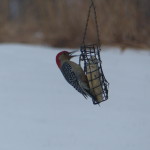
-
Wintering woodpeckers, including the pileated, gobble up suet.
-
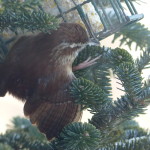
-
A lone Carolina Wren has hung around and appreciates the suet on our outdoor Christmas Tree.
-
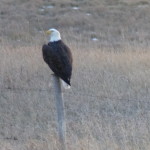
-
Eagles have come down from the north. As waterways freeze over they concentrate below roller dams.
-
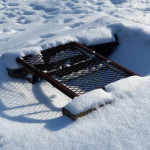
-
Lonely winter grill
-
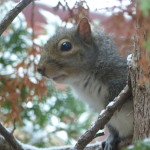
-
A cautious squirrel scoping out the action.
-
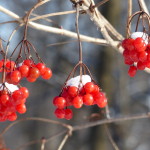
-
The birds have not yet flocked to the High Bush Cranberries but will later in the winter.
by Winding Pathways | Jan 2, 2016 | Nature, Reflections/Profiles, Wonderment
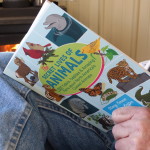
This great book is colorful, factual and encourages folks to “Go Outside!”
As kids growing up, we read books our classmates would have considered weird. They were field guides to birds, mammals, fish, wildflowers, rocks and the weather. Color plates of animals, trees and all sorts of other living things fascinated us. Range maps taught geography, and the text good writing.
With the rapid growth of apps to help identify many objects of nature, field guides may be slipping from winter reading lists, but there is one new book that any nature lover should have handy.
The Secret Lives of Animals includes 1001 tidbits, oddities and facts about North America’s wild animals. It’s not a book to read cover to cover. It is one to pick up when there are a few spare minutes for learning and enjoyment. There’s learning on every page. We see two audiences who will enjoy having this book close by.
Kids and adolescents: With colorful illustrations and loads of facts presented in succinct form it’s a fascinating book for youngsters. We would have loved to have had this book by our bedside when we were young to glean wildlife snippets in moments before sleep.
Adults: The book is studded with interesting facts and makes a good one minute or three hour read. Any trivia lover will enjoy it as well as people who delight in wildlife.
Our favorite part of the book appears frequently and is called GO OUTSIDE. Going outside and enjoying nature is what we advocate at Winding Pathways and The Secret Lives of Animals gives readers something new to look for outdoors and then encourages them to put the book down, pull on the boots and go explore outside.
THE SECRET LIVES OF ANIMALS-1001 Tidbits, Oddities, & Amazing Facts About America’s Coolest Animals, by Stacy Torino and Ken Keffer with illustrations by Rachel Riordan. FalconGuides. ISBN 978-1-4930-1191-9. http://amzn.to/1PMc5EJ
by Winding Pathways | Dec 30, 2015 | Birds, Mammals, Nature, Pests
Watching backyard wildlife yields amazing sights and education. We recently noticed two things at Winding Pathways that reminded us about how many animals are downright smart.
Both involved a manufactured trap that supposedly catches House Sparrows. We have more of this pesky bird than we’d like so we set the trap under a feeder and baited it with cracked corn. A few minutes later an intrepid chipmunk entered the trap’s funnel-like door, feasted on seeds, and couldn’t find his way out. We gently released him and set the trap back on the corn.
A few minutes later we were amazed to see the chipmunk back and watch it tunnel under the trap to reach the bait! He’d learned that entering the trap brought trouble and figured out how to safely reach lunch.
Our sparrows are even smarter than the chipmunk. Not a single one entered the trap. Instead they feasted on corn and millet on the ground around the feeder. After a few hours they had eaten all the safe seed but they still wouldn’t enter the trap.
We now have new respect for the intelligence of both chipmunks and House Sparrows.
-
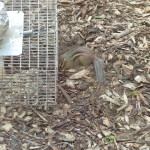
-
The chipmunk figured out how to tunnel under the live trap to reach the corn.
-
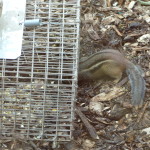
-
Having excavated, the chipmunk now enters the tunnel to get the corn.
-
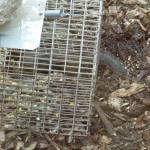
-
In and Under!
-
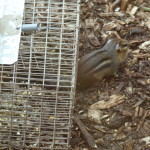
-
With pouches full, the chipmunk emerges.
-
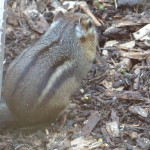
-
The chipmunk figured how to tunnel under the live trap, gather up the corn and emerged with pouches full.
by Winding Pathways | Dec 25, 2015 | Birds, Nature

De-light the tree if you must and adorn it with seed for greater natural delights!
After the holiday cheer fades and ornaments are stored away the Christmas tree can enjoy a second life alive with birds.
Nothing makes a better bird feeder than an upright fir. We take our old tree outside and set it upright. We either use the stand to hold it, dig a hole in the ground deep enough to hold the tree upright, or pound a tall stake into the ground and tie the tree to it. A few strings going out to stakes in the ground will keep it standing in high wind.
Then the fun starts. We pour a couple of cups of birdseed on the very top of the tree and let it settle down into the needles. Larger seeds, like peanuts and gray striped sunflower, work best.
So many birds flock to our tree to find seeds within its branches that it quivers with life and color.
Good sources of seeds include your local feed and wild bird stores, Amazon, Kaytee Products, and Pine Tree Farms, Inc, and of course, many others.
by Winding Pathways | Dec 19, 2015 | Birds, Nature
Christmas trees bring Holiday spirit to a home but come at a cost. We love balsam firs for their beauty and wonderful fragrance, but we don’t fancy sweeping up needles as the drying tree sheds.
This year we found the solution. We set the fir up on the deck just outside our living room. A large window gives great viewing and several strings keep it upright on windy days. Instead of normal decorations we bought several bell shaped pressed seeds, a thistle sock, and some small feeders and decorated the tree for the birds. Each morning we pour peanuts and sunflower seed at the tree’s top and many seeds settle on branches.
Our tree is alive with birds and squirrels all day. They are our living ornaments. And, after the Christmas season is over all we need to do is untie the strings, remove the tree from the stand, and sweep the deck off.
Marion and Rich at Winding Pathways wish you a pleasant winter holiday and a happy and healthy 2016.
PUTTING THE OLD TREE TO USE
Winding Pathways is near Cedar Rapids, Iowa where Indian Creek Nature Center accepts donated Christmas trees in January. They are chipped and volunteers spread the aromatic chips on trails. A walk on a freshly chipped trail smells like the north woods stroll.
Many other nature centers and towns recycle trees, but they can also be used around the home. Clip off the branches, let them dry and needles fall, and make kindling from the branches for summer cookouts. The stem makes a great garden pole. Set it upright and plant a few pole bean seeds in May. By July the tree will support delicious green beans.
-
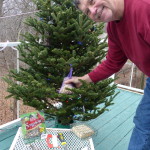
-
Rich bought a variety of bird seed and suet that has been a big hit with wildlife.
-
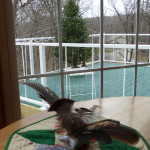
-
From the comfort of the house, we can enjoy the animal antics.
-
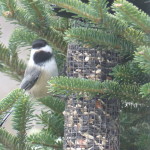
-
Checking out the treats!
-
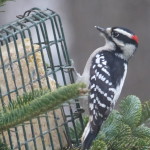
-
Ready to feed.
-
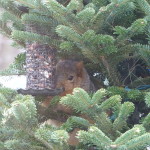
-
The squirrels quickly find that hiding among the branches gives them protection from the wind, predators and excellent vantage for eating!



















